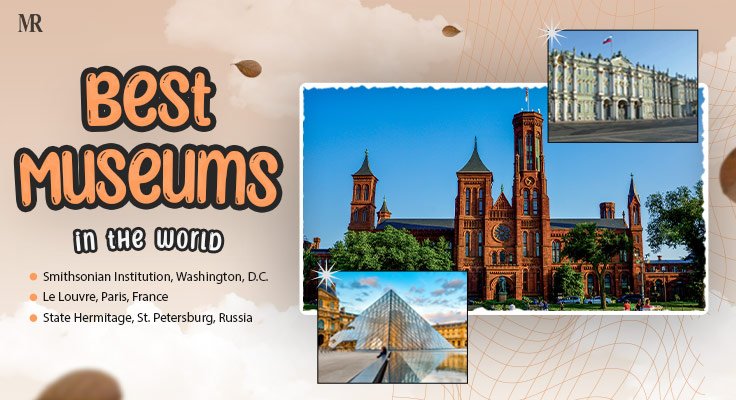Have you ever felt that spine-tingling thrill of standing inches away from a masterpiece that has shaped history? It’s a feeling that stays with you forever. The best museums in the world are more than just buildings with old objects; they are electrifying portals to our shared human story. Inside these incredible institutions, you can feel the pulse of civilizations, from the genius of Renaissance art to the mysteries of ancient worlds.
This isn’t just about seeing famous art; it’s about feeling it. For anyone with a curious heart and a traveler’s soul, this guide is your personal key. We’re about to take you on an unforgettable journey, revealing the must-see works, the powerful stories, and the secret corners of these cultural giants. Get ready for a quest that will fill your heart and mind with wonder.
Let’s Explore the 7 Best Museums in the World
| S.No. | Best Museums in the World |
| Smithsonian Institution, Washington, D.C. | |
| Le Louvre, Paris, France | |
| State Hermitage, St. Petersburg, Russia | |
| The British Museum, London, England | |
| The Prado, Madrid, Spain | |
| The Vatican Museums, Vatican City | |
| Rijksmuseum, Amsterdam, the Netherlands |
1. Smithsonian Institution, Washington, D.C.
Wow, just try to picture this: not one museum, but a jaw-dropping collection of 19 museums and galleries! The Smithsonian Institution is, without a doubt, the world’s largest museum and research complex. Its fame isn’t tied to a single painting or sculpture but to its absolutely massive diversity, covering everything from art and science to history and space. It’s a true beacon of knowledge that has shaped what American museums are today.
- The Story of Its Name
Here’s a fascinating piece of trivia for you! The museum is named after James Smithson, a British scientist who, in 1826, left his entire fortune to establish the Institution. And the most surprising part? He had never even set foot in America! His generous gift, which brought the museum to life in 1846, was a beautiful gesture aimed at spreading knowledge for all.
- Visitor Volume & Global Impact
Hold on to your hats—the Smithsonian welcomes over 30 million visitors every single year! That’s an incredible number of people, from scholars to families, all drawn to its vast collections of American history and priceless artifacts.
- What Makes It Rank Among the Best
What truly sets the Smithsonian apart is its unbelievable scale and variety. It’s like a living encyclopedia of human achievement, masterfully connecting science with our cultural heritage. It’s a place designed to educate, inspire, and create a bond between generations. Isn’t that impressive?
- Insider’s Guide: Timings, Rules & Tips
- Timings: Most of the museums are open every day from 10 AM to 5:30 PM, but it’s always smart to check their schedules for any special exhibitions.
- Rules: The best part? Entry is free! Just remember the standard museum etiquette: no flash photography where indicated, and keep food out of the galleries.
- Pro-Tips: Here’s a little secret for you. Kick off your adventure at the National Museum of Natural History to see the ancient civilizations exhibits, then head straight to the National Air and Space Museum to dodge the afternoon rush. Also, the Smithsonian mobile app is a lifesaver for custom tours!
- Unmissable Hidden Gem
While everyone is exploring the larger-than-life exhibits, make sure you find the Hope Diamond at the National Museum of Natural History. This legendary gem is absolutely mesmerizing and is surrounded by fascinating stories that often get missed.
2. Le Louvre, Paris, France
Ah, the Louvre! Its worldwide fame comes from two incredible sources: its past life as a grand royal palace and its mind-blowing art collection filled with universally adored masterpieces. It brilliantly weaves together centuries of European art, from classic sculptures to Renaissance paintings, making it a true pillar of artistic excellence.
- The Story of Its Name
Ever wondered where the name ‘Louvre’ came from? It’s believed to have originated from the Old French word ‘levre,’ meaning wolf, which might hint at the wild, medieval landscape it was once built on. It transformed from a fortress into France’s top national museum—a symbol of cultural pride.
- Visitor Volume & Global Impact
With more than 9 million visitors flocking to it each year, the Louvre proudly holds the title of the world’s most visited museum. That’s a powerful testament to its importance as a home for cultural heritage and historical treasures.
- What Makes It Rank Among the Best
The Louvre is a temple of art, plain and simple. It houses irreplaceable cultural artifacts like the enigmatic Mona Lisa and the stunning Venus de Milo. Its complete command over the art history timeline solidifies its place as an emblem of Western artistic genius.
- Insider’s Guide: Timings, Rules & Tips
- Timings: It’s open from 9 AM to 6 PM daily but takes a rest on Tuesdays. Want a magical experience? Visit on Wednesdays and Fridays for late nights until 9:45 PM.
- Rules: Feel free to take pictures, but without a flash. Large bags are a no-go, and be sure to wear your comfiest shoes!
- Pro-Tips: To feel like a real insider, use the lesser-known Porte des Lions entrance to skip the massive crowds. For a more peaceful visit, aim for early mornings or weekday evenings. Start with the Denon Wing to see iconic paintings, including the Mona Lisa.
- Unmissable Hidden Gem
Don’t leave without discovering the Islamic Arts Department. It’s a breathtakingly modern addition that showcases some of the most exquisite craftsmanship, often overlooked by visitors rushing to the main galleries.
3. State Hermitage, St. Petersburg, Russia
The State Hermitage owes its legendary status to Catherine the Great, who started this visionary collection way back in 1764. It’s a cultural powerhouse with over three million artifacts! Imagine the sheer grandeur of its architecture combined with an encyclopedic collection of European art, from ancient civilizations to modern masterpieces. It’s a beautiful expression of Russia’s national identity.
- The Story of Its Name
The name ‘Hermitage’ beautifully reflects its origins as a private retreat, a concept inspired by European aristocrats. It was envisioned as a sanctuary, a quiet place where treasures of art and history could be admired and inspire deep thoughts.
- Visitor Volume & Global Impact
Drawing around 4.5 million visitors annually, the Hermitage is a cultural magnet, deeply woven into the fabric of Russian history and heritage.
- What Makes It Rank Among the Best
What makes the Hermitage so elite is its immense and incredibly diverse collection, all housed within the lavish Winter Palace. A visit here feels like an immersive journey through multiple centuries of art, history, and culture that you simply can’t find anywhere else.
- Insider’s Guide: Timings, Rules & Tips
- Timings: Open from Tuesday to Sunday, 10:30 AM to 6 PM. Enjoy extended hours on Wednesdays and Fridays until 9 PM. It’s closed on Mondays.
- Rules: Be mindful of bag size restrictions, photography is usually fine without a flash, and a quiet, respectful atmosphere is appreciated.
- Pro-Tips: Definitely pre-book your tickets! To escape the crowds, explore the lesser-known artist studios and the Small Hermitage. An audio guide can be a great companion for galleries that are harder to access.
- Unmissable Hidden Gem
You have to experience the Peacock Clock! It’s an exquisite 18th-century automaton—a mechanical marvel that blends art and engineering. It’s located in an often-missed room and is an absolute delight.
4. The British Museum, London, England
The British Museum holds a special place in history as the very first national museum dedicated to showcasing universal human knowledge from all cultures. Its fame comes from its vast collection of artifacts from global cultural heritage sites, including world-changing items like the Rosetta Stone. It champions enlightenment and scholarly debate, which redefined what a museum could be.
- The Story of Its Name
Named simply for its location in London, the museum was born from the private collection of Sir Hans Sloane in 1753. Its creation was fueled by the Enlightenment dream of making knowledge accessible to every single person.
- Visitor Volume & Global Impact
Over 6 million people walk through its grand halls each year, witnessing a collection of some 13 million objects! It’s a crucial institution that connects art history with our ongoing cultural conversations.
- What Makes It Rank Among the Best
The British Museum is more than just a place for objects; it’s a global cultural conscience. It’s celebrated for its dedication to presenting the incredible diversity of human history while bravely engaging in important discussions about contested artifacts.
- Insider’s Guide: Timings, Rules & Tips
- Timings: Open daily from 10 AM to 5:30 PM, with a late closing on Fridays at 8:30 PM.
- Rules: No flash photography is allowed, leave large bags behind, and always be respectful of the space.
- Pro-Tips: For an amazing start, head to the Egyptian galleries to see the ancient marvels first. Grab a map to navigate the huge space efficiently, and if you can, visit on a weekday to avoid the weekend crowds.
- Unmissable Hidden Gem
Make your way to the Enlightenment Gallery. It offers a truly thought-provoking look into the intellectual world of the 18th century and the museum’s own origins. It’s a fascinating corner that many casual visitors skip right past.
5. The Prado, Madrid, Spain
The Prado’s reputation is built on its unparalleled collection of Spanish art, especially from the Renaissance and Baroque periods, including masterpieces from Dutch Golden Age painters. It’s the home of Velázquez’s Las Meninas and other iconic works, solidifying its role as a protector of Spain’s rich artistic identity.
- The Story of Its Name
‘Prado’ translates to ‘meadow,’ a nod to the museum’s original location. Founded in 1819, it was built on what used to be royal hunting grounds in Madrid, beautifully symbolizing a place where art could flourish just like nature.
- Visitor Volume & Global Impact
Welcoming about 3 million visitors each year, the Prado holds a commanding position in the world of European art collections, celebrated for its prestige and influence.
- What Makes It Rank Among the Best
Its incredible depth of artistic masterpieces, combined with its historical richness and modern approach to curation and public engagement, firmly secures its spot among the world’s greatest museums.
- Insider’s Guide: Timings, Rules & Tips
- Timings: The museum is open from Tuesday to Sunday, 10 AM to 8 PM, and is closed on Mondays.
- Rules: Photography is not allowed inside the galleries, so be prepared to soak it all in with your eyes. Secure your belongings and embrace the quiet, reflective atmosphere.
- Pro-Tips: Visit early in the morning or later in the afternoon. Make a beeline for the Velázquez and Goya rooms first. Using an audio guide can give you a much deeper appreciation of the works.
- Unmissable Hidden Gem
Seek out the lesser-known Ruiz de Luna ceramic tiles in the museum’s inner courtyard. They reveal a beautiful side of Spain’s artisanal heritage and offer a wonderful, tactile contrast to the grandeur of the paintings.
6. The Vatican Museums, Vatican City
The Vatican Museums are truly one-of-a-kind, forming a powerful connection between religion, art, and history right in the heart of Catholicism. The collection is packed with masterpieces from Renaissance giants like Michelangelo, whose world-famous Sistine Chapel ceiling is a sight to behold. It’s a monumental cultural heritage site shaped by centuries of papal patronage.
- The Story of Its Name
Named simply for their location within Vatican City, these museums began as private collections for the popes before they grew into the internationally revered cultural institutions they are today.
- Visitor Volume & Global Impact
Drawing nearly 7 million visitors every year, they offer a singular fusion of spiritual meaning and artistic genius, leaving a lasting impact on travelers and scholars from all over the world.
- What Makes It Rank Among the Best
The Vatican Museums are an unrivaled destination for art lovers. Their unparalleled collection of sacred art, breathtaking architecture, and holy relics, combined with groundbreaking Renaissance masterpieces, makes for a truly profound experience.
- Insider’s Guide: Timings, Rules & Tips
- Timings: Open from Monday to Saturday, 9 AM to 6 PM. They are closed on most Sundays, but on the last Sunday of the month, entry is free!
- Rules: There’s a strict dress code: shoulders and knees must be covered. Photography is forbidden in the Sistine Chapel, and large bags are not permitted.
- Pro-Tips: You’ll thank yourself for pre-booking skip-the-line tickets! Prioritize an early morning visit to the Sistine Chapel to see it at its most serene. A guided tour can also unlock so many hidden stories.
- Unmissable Hidden Gem
Don’t miss the Gallery of Maps! It’s a stunning corridor lined with 16th-century fresco maps that offers an absolutely breathtaking—and often overlooked—glimpse into Renaissance cartography and how they saw the world.
7. Rijksmuseum, Amsterdam, the Netherlands
The Rijksmuseum is the ultimate home for Dutch national art and history, and its fame is anchored by its incredible collection of masterpieces from Dutch Golden Age painters like Rembrandt and Vermeer. Its cutting-edge restoration techniques and thoughtfully designed exhibitions make it a leader among Europe’s iconic museum buildings.
- The Story of Its Name
“Rijks” simply means “state” or “national.” Established in 1800, the museum was created to be the Netherlands’ national showcase of art and history, a powerful symbol of state pride and cultural preservation.
- Visitor Volume & Global Impact
Each year, over 2.7 million visitors are drawn to its 80 magnificent galleries, which are filled with incredible works spanning 800 years of art and history.
- What Makes It Rank Among the Best
The Rijksmuseum is essential for any cultural explorer. It not only offers world-class European art collections but also masterfully curated exhibits on ancient civilizations. This, along with its advanced digital outreach, makes it a truly modern and vital institution.
- Insider’s Guide: Timings, Rules & Tips
- Timings: Simple and easy to remember: open daily from 9 AM to 5 PM.
- Rules: You can take photos, just without the flash. Be sure to respect the boundaries around the artwork. Guided visits are highly encouraged to get the full story.
- Pro-Tips: Head to see Rembrandt’s ‘The Night Watch’ early in the day to beat the crowds. Explore the newly renovated Philips Wing for a fresh take. The Rijksmuseum app is fantastic for creating your own customized tour.
- Unmissable Hidden Gem
Venture into the Gallery of Pastels. Here you’ll find a unique and intimate collection of framed pastel artworks by Dutch masters from the 17th to 20th centuries. It’s a quiet and beautiful escape from the main crowds.
My Opinion
The best museums in the world are so much more than quiet halls of relics; they are living, breathing spaces that act as custodians of our collective memory and spark vital conversations across time and borders. Beyond just protecting historical artifacts and artistic masterpieces, they truly shape our identity and our dreams.
These incredible institutions are constantly in dialogue with our present moment, helping us understand our complex past while fueling the creativity of our future. What keeps the world’s top museums so alive is their amazing ability to evolve—embracing everything from digital innovation to more inclusive storytelling.
This widens our access to these precious cultural sites. In a world that often feels divided, these museums stand as brilliant beacons of knowledge, empathy, and artistic excellence—they are absolutely essential resources in our ongoing human search for understanding and connection.
Here Are Some Museum Tips for You
- The ‘Focus on One’ Power Move:
Instead of rushing, pick just one masterpiece to spend quality time with at the start of your visit. This simple act anchors your experience and gives you a richer perspective on everything else you see.
- Follow the Curator’s Secret Trail:
Check online or ask at the information desk for a curator-recommended route. These special paths often reveal surprising themes and connections between artworks that you’d otherwise miss.
- Have a Silent Conversation with Art:
Don’t just look—truly see. Pause between artworks to reflect or jot down a few thoughts. This transforms your visit from passive viewing into an active, personal dialogue with history.
- Your Digital Pocket Guide:
Use the museum’s official app or an augmented reality guide. They don’t just give you facts; they unlock hidden stories, artist insights, and fun interactive features that bring the exhibits to life.
- The Full 360° Experience:
Your visit doesn’t have to end at the exit. Explore the museum’s online resources before you go and check for post-visit talks or exhibitions. This turns a single visit into a much deeper and more lasting journey.
Loved this ultimate guide to the 7 best museums in the world? Don’t keep this inspiration to yourself! Share it with your fellow culture lovers, friends, and family right now—let’s ignite everyone’s wanderlust and kick off a collective cultural quest!












